Using light to create mood in photography is like putting on glasses that let you see feelings; you’re crafting stories with shadows and highlights. Ever tried snapping a photo during golden hour? It’s magical! The soft, warm glow can make your pet rock look like it deserves an Oscar. Playing with backlighting adds a halo effect, wonderful for a tale that needs a pinch of mystery or magic. And hey, don’t shy away from shadows; they add depth and drama. Learning to master light, whether natural or from a softbox, transforms your photos into emotional treasures. Discover more about your new role as a light magician.
Important Highlights
- Master different lighting techniques like soft, hard, and backlighting to evoke varied emotional tones.
- Utilize natural light conditions, such as the golden hour, to enhance the mood and warmth of photographs.
- Experiment with artificial light sources, like softboxes and ring lights, for precise mood control in images.
- Adjust contrast and saturation in post-processing to deepen shadows and shift emotional tones in photos.
- Understand how light direction and intensity influence shadows and highlights, adding depth and interest.
Understanding Light in Photography
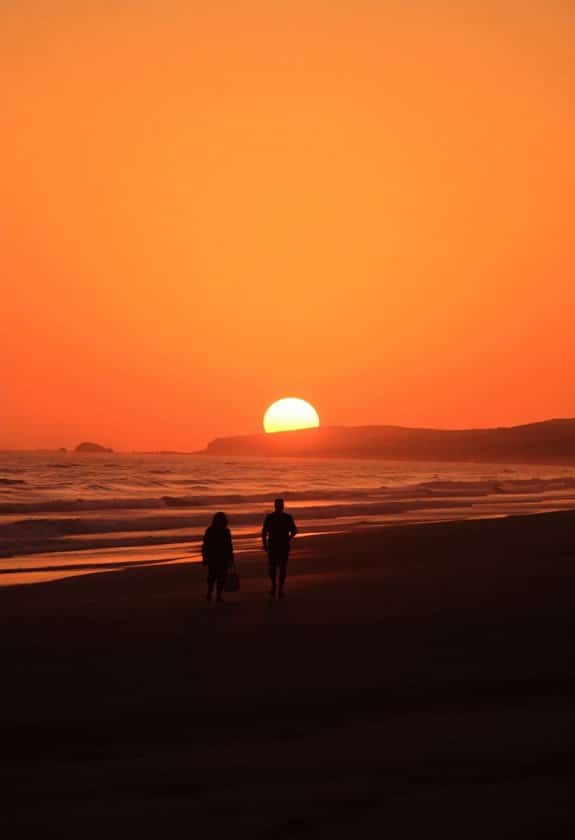
Grasping the nuances of light in photography can transform your images from ordinary to extraordinary. Imagine having the power to change how a picture feels just by tweaking the light.
When you understand light, you can make a photo look warm and inviting or cool and mysterious, all while keeping things safe and sound. I remember my first time experimenting with natural light; it was like discovering a secret superpower.
By playing around with the angle of the sun, I realized how shadows can add depth, making everything more interesting. It’s important to remember that light can be your best friend, helping you capture moments that are both beautiful and secure. Utilizing tools like softbox lights can enhance your control over lighting conditions.
Types of Lighting Techniques
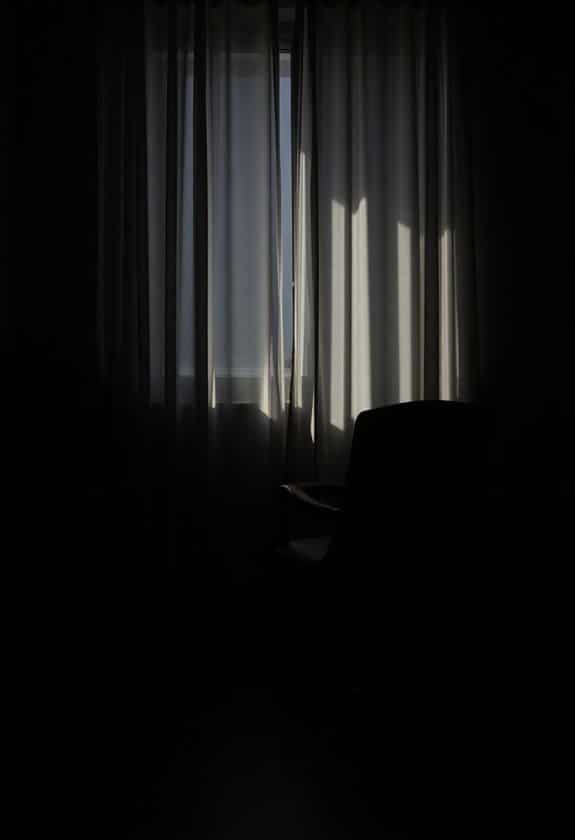
When it comes to photography, understanding various lighting techniques can elevate your work to new levels. You might find it challenging at first, but don’t worry—practice makes perfect!
Remember the time I tried using backlighting for the first time and ended up with a silhouette that looked like a mysterious shadow puppet? It was a fun learning experience.
To create different moods safely, consider these techniques:
- Soft Lighting: Creates gentle shadows, perfect for portraits.
- Hard Lighting: Offers sharp shadows, adding drama to your scenes.
- Backlighting: Highlights the edges, giving an ethereal glow.
- Fill Lighting: Balances shadows, ensuring nothing looks too harsh.
These techniques can help you control and shape the light in your photos, making them more dynamic and expressive. Additionally, using soft diffusion from softbox lights can enhance your portraits by reducing harsh shadows.
Keep experimenting, and you’ll capture amazing shots!
Natural Light and Mood
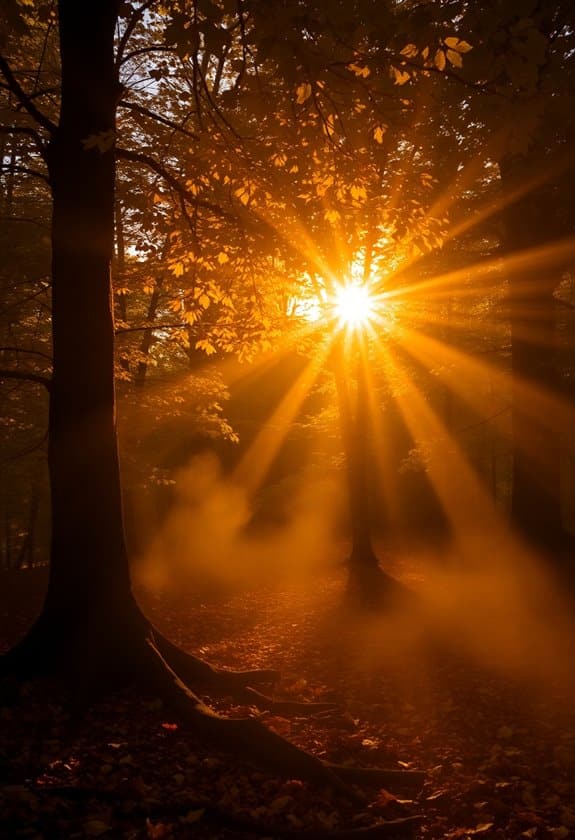
Natural light can profoundly influence the mood of your photographs, offering a spectrum of possibilities from dawn to dusk.
Envision this: early morning light casts a soft, gentle glow, perfect for creating a peaceful, serene mood in your photos. As the day progresses, the sun climbs higher, and the light becomes harsher, ideal for dramatic, high-contrast images.
You might find yourself chasing the golden hour, that magical time just before sunset when everything seems bathed in a warm, golden hue. This light can make your subjects look almost magical! It’s like nature’s own spotlight, highlighting beauty safely and naturally.
But be cautious; the midday sun can be intense. Seek shaded areas to avoid harsh shadows, ensuring your photos remain inviting and comforting.
Artificial Light Sources
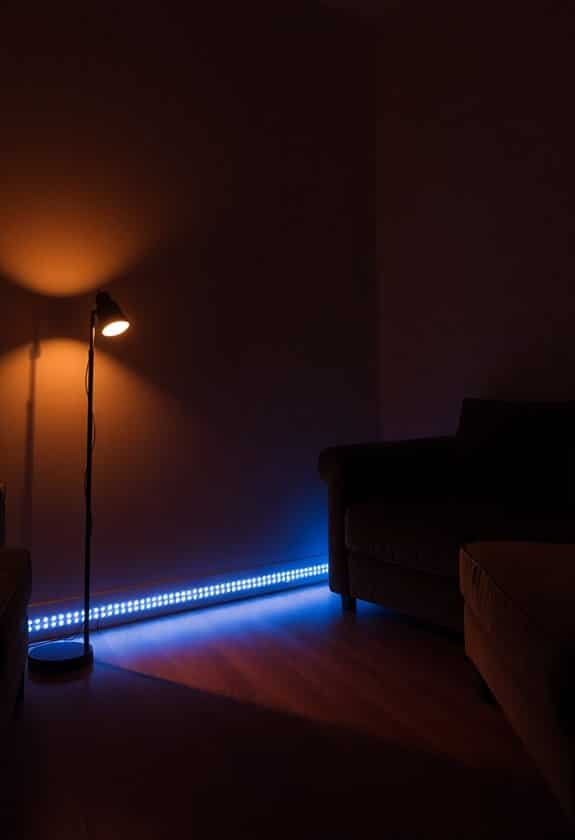
While natural light offers an array of moods, sometimes you need more control over your lighting conditions.
That’s where artificial light sources come in handy. They’re like your trusty sidekick, always ready to help set the perfect mood, whether it’s cozy or dramatic. Think of them as your personal sunshine!
Here’s a quick guide to get you started:
- LED Lights: Safe and energy-efficient, these are great for beginners.
- Softboxes: They spread the light out evenly, giving everything a nice, soft glow, perfect for portraits.
- Ring Lights: Ideal for close-ups and selfies, they’ll make your subject pop without harsh shadows. These lights offer adjustable brightness levels that can enhance the overall lighting quality in your shots.
- Flash Units: These provide a quick burst of light, capturing action perfectly.
With the right tools, you’ll create photos full of feeling!
Shadows and Contrast Effects
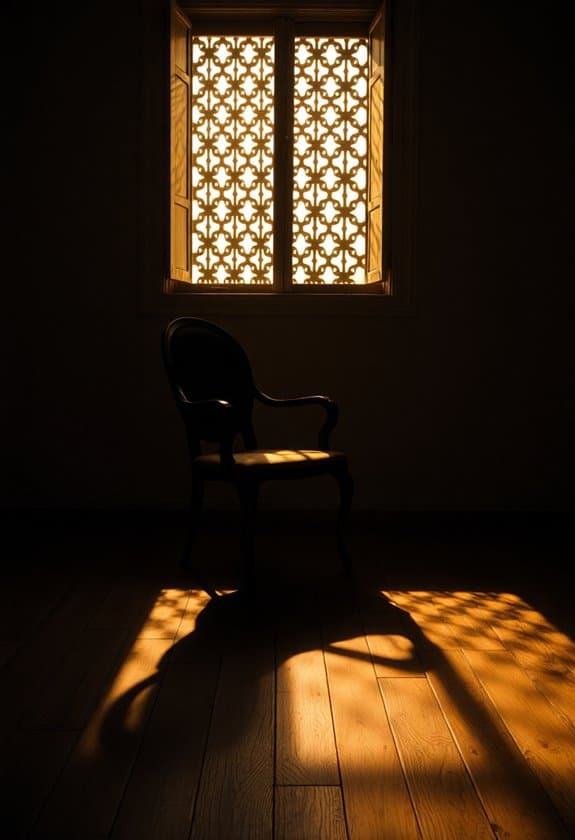
Shadows are the unsung heroes of photography, adding depth and drama to your images. They create contrast, which helps highlight the subject, like a spotlight in a play.
Ever notice how a shadow can make a simple object look mysterious or exciting? It’s like when you’re at the movies, and the villain lurks in the shadows.
You can play with shadows by adjusting the light source’s angle. Try moving a lamp around a toy; watch the shadow dance and change shape.
Always be aware of how shadows can enhance your photo’s story. Just remember, you’re in control.
The right lighting gear choices can significantly influence the quality of shadows and contrast in your photography.
Keep experimenting, and soon you’ll find the perfect balance between light and shadow, crafting images that are both safe and enchanting.
Color Temperature Impact
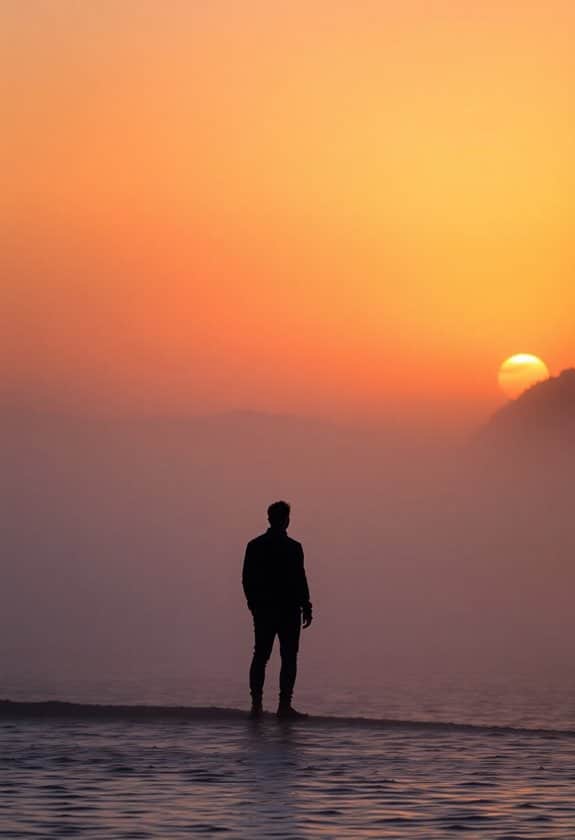
Color temperature in photography affects the mood and feel of your images, much like a painter’s palette shapes a masterpiece.
You mightn’t realize it, but different light sources can make your photos look warm and cozy or cool and calm.
It’s like adjusting the thermostat for your pictures—every little change can make a big difference.
Here’s how you can safely play with color temperature:
- Warm tones: Use sunlight or tungsten lights for a comfortable, inviting feel. Think of those golden sunsets.
- Cool tones: Fluorescent or LED lights add a modern, fresh vibe, perfect for slick cityscapes.
- Neutral balance: Combine both to maintain a natural look, like capturing a candid moment.
- Post-adjustments: Editing software can tweak temperature, allowing you to experiment without worry.
Experimenting With Light Angles

When you experiment with light angles in photography, you reveal a myriad of possibilities to enhance your images. Imagine being a director on a film set—except you’re working with sunlight or a lamp.
Changing the angle can dramatically affect the mood. If you tilt a light source to the side, you create dramatic shadows, adding mystery. Point it directly at your subject, and you illuminate every detail, creating a sense of openness. The right portable lighting option can significantly improve your control over light angles.
Once, I shot a photo of my cat, and by moving the light higher, she looked like a regal lion!
Post-Processing for Mood Enhancement

In the domain of photography, post-processing can be a powerful tool to enhance the mood of your images. You know, it’s like adding that final brushstroke to a painting.
When you’re editing, think about the story you want to tell. Do you want your photo to feel warm and inviting, or maybe mysterious and moody?
Here are some tips to safely enhance mood through post-processing:
- Adjust the contrast: Enhancing shadows and highlights can add drama.
- Play with saturation: Boosting or muting colors can shift the mood.
- Experiment with filters: They can transform a scene’s emotion.
- Tweak brightness: Brightening or darkening areas can guide the viewer’s eye.
Additionally, utilizing tools like the TourBox Elite can streamline your editing process and allow for more precise adjustments in mood enhancement.
Frequently Asked Questions
How Does the Time of Day Affect Mood in Photography?
You know, the time of day can change how a photo feels.
Imagine capturing a sunrise; it’s like the world’s waking up with soft, gentle light that feels peaceful.
But if you’re shooting at noon, the sun’s all bright and harsh, like it’s had too much coffee, creating strong contrasts.
Evening light’s warm and cozy, perfect for a safe, inviting vibe.
What Role Does Lens Choice Play in Light Manipulation?
Did you know that 85% of the image’s impact comes from lens choice?
When you’re picking a lens, you’re not just deciding on focal length; you’re also shaping how light interacts with your subject.
Wide-angle lenses can let in more light, making scenes feel open and safe.
Meanwhile, telephoto lenses can focus light, creating a cozy or intense mood.
It’s like choosing the perfect flashlight for a camping story—each one sets a different scene.
Can Camera Settings Influence the Mood Created by Lighting?
Absolutely, your camera settings can shape the mood created by lighting.
Think of it like choosing your outfit for a day—it sets the tone. Adjusting the aperture can soften the light, giving a dreamy vibe, while a faster shutter speed can freeze a moment, adding intensity.
Remember when I tried capturing a sunset? I played with ISO settings until the colors popped just right.
It’s like painting with light, and you’re the artist!
What Accessories Can Enhance Mood Lighting in Photography?
Imagine using accessories in photography like adding spices to a dish—they enhance the flavor.
To set the mood with light, try using diffusers to soften harsh rays, creating a cozy atmosphere. Reflectors can bounce light, highlighting your subject safely and warmly. Gels add color, like painting with light, changing the vibe instantly.
As a filmmaker, I’ve learned these tools are like magic wands, transforming ordinary scenes into enchanting stories.
How Do Different Weather Conditions Impact Lighting Mood?
You know, the weather can really change the vibe of your photos. On a sunny day, you’ll get bright, happy shots with lots of shadows.
But when it’s cloudy, everything looks softer and more mysterious—perfect for those thoughtful, moody pictures.
Rain adds drama; just watch out for your camera!
Once, I shot in the fog and it felt like a scene from a fairytale.
Each weather type tells its own story, so experiment safely!




